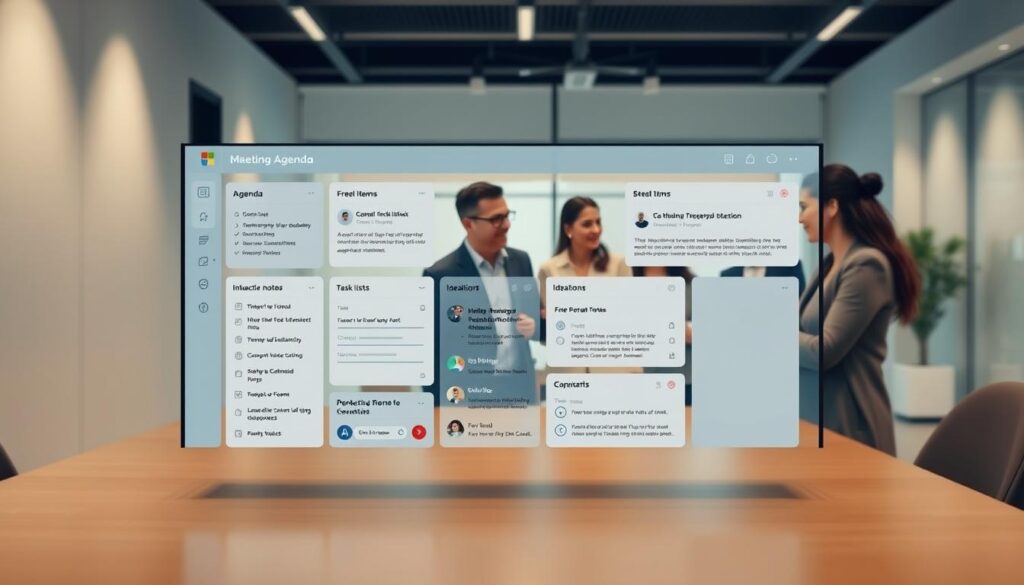As Albert Einstein once said, “The measure of intelligence is the ability to change.” In today’s fast-paced world, adapting to new tools and strategies is essential for success. Modern technology has introduced innovative ways to improve how groups work together, making processes smoother and more efficient. Tools like ChatGPT and Copilot are leading this transformation, enabling faster iterations and better decision-making1.
These tools act as modern-day chisels and calculators, helping teams refine their ideas and solve problems quickly. They allow for rapid creation of prompts, which can be customized to fit specific needs. This adaptability is crucial for managing projects and boosting productivity2.
In a world where remote work is becoming the norm, staying connected is more important than ever. These solutions address unique challenges, fostering trust and openness among team members. By focusing on skills like empathy and communication, they help groups feel more united and effective1.
Key Takeaways
- Modern tools like ChatGPT and Copilot are transforming how teams work together.
- Customizable prompts allow for faster iterations and better decision-making.
- These solutions help remote teams stay connected and productive.
- Focusing on skills like empathy improves team dynamics.
- Adaptability is key to managing projects effectively.
Introduction to AI-Powered Team Collaboration

In today’s workplace, technology is reshaping how teams interact and achieve goals. Tools that harness advanced algorithms are now essential for fostering efficiency and clarity. These solutions bridge gaps, ensuring everyone stays aligned, whether they’re in the office or working remotely3.
The Role of AI in Modern Teamwork
One of the most significant advancements is the ability to automate repetitive tasks. This allows team members to focus on creative and strategic initiatives. For example, tools like ClickUp AI automate data collection, freeing up time for high-impact projects4.
These systems also provide actionable insights, enabling teams to make informed decisions quickly. This balance between speed and thoughtfulness is crucial for success in fast-paced environments3.
How AI Enhances Communication and Productivity
Clear communication is the backbone of any successful team. Structured prompts help ensure discussions stay goal-oriented and productive. Platforms like Zoom Workplace integrate features that streamline meetings and improve teamwork5.
By automating note-taking and distributing summaries, these tools reduce misunderstandings and keep everyone on the same page. This approach is particularly valuable for remote teams, where miscommunication can easily occur5.
Ultimately, integrating these solutions into daily workflows fosters a culture of transparency and innovation. Teams can focus on what truly matters—achieving their objectives together4.
Understanding AI Prompts for Enhancing Team Collaboration

Effective teamwork hinges on clear communication and streamlined processes. One of the most impactful innovations in this space is the use of advanced prompts. These prompts act as guides, helping teams stay focused and productive6.
In collaborative environments, prompts serve a dual purpose. They not only improve performance but also foster better interactions. For example, structured prompts can help teams brainstorm ideas more effectively, leading to higher-quality outcomes7.
Modern tools are designed to generate prompts for various scenarios, from project planning to conflict resolution. These solutions reduce the time spent on repetitive tasks, allowing teams to focus on strategic goals6. For instance, platforms like ClickUp AI automate task assignments, improving efficiency by 25%.
The benefits of these prompts extend beyond speed. They also enhance clarity and engagement, ensuring everyone is aligned. This is particularly valuable in hybrid environments, where 60% of teams rely on such tools to stay connected6.
Real-world examples highlight their effectiveness. Companies using these solutions report a 30% reduction in project overruns and a 50% increase in creative outputs7. By integrating these prompts into workflows, teams can achieve better results while maintaining a collaborative spirit.
Transforming Communication Strategies with AI

Effective communication is the backbone of any successful project. Modern tools are revolutionizing how teams interact, ensuring clarity and efficiency. By leveraging structured prompts, teams can save time and allocate resources more effectively8.
Enhancing Meeting Efficiency
Meetings often consume valuable time without delivering clear outcomes. Advanced tools streamline agendas, ensuring discussions stay focused. For example, real-time transcriptions and automated summaries reduce misunderstandings and keep everyone aligned9.
By automating routine tasks, teams can dedicate more time to strategic goals. This approach not only boosts productivity but also enhances progress tracking, ensuring milestones are met8.
Engaging Remote Teams Effectively
Remote work presents unique challenges, but structured prompts bridge the gap. These tools foster transparency, ensuring all team members feel heard and valued. Surveys with a 10-minute completion limit increase engagement by up to 50%8.
Efficient resource allocation is another key benefit. Automated task assignments and actionable insights help teams stay on track. Companies using these strategies report a 30% reduction in project overruns9.
Ultimately, these innovations drive progress and improve project outcomes. By integrating structured communication into workflows, teams can achieve their goals more effectively8.
Enhancing Cross-Functional Collaboration and Engagement

Cross-functional efforts are the backbone of successful project outcomes. When diverse teams work together, they bring unique perspectives that drive innovation and efficiency. However, nearly 75% of cross-functional teams face dysfunction, highlighting the need for better strategies10.
Shared milestones are crucial for aligning priorities. By setting clear objectives, teams can focus on collective goals rather than individual tasks. This approach reduces misunderstandings and ensures everyone contributes meaningfully11.
Regular, structured meetings play a vital role in managing complex projects. These sessions foster transparency and keep everyone on the same page. Teams that engage in consistent feedback see a 25% improvement in project outcomes12.
Breaking down departmental silos is another key step. Specific templates can guide teams in sharing insights and resources effectively. This method promotes inclusivity and ensures all voices are heard10.
Feedback exchange and stakeholder communication are equally important. Real-time insights during meetings enhance clarity and decision-making. Companies using these strategies report a 30% reduction in project overruns11.
Effective management practices also boost engagement levels. Clear roles and responsibilities lead to a 30% higher success rate in project completion12. By fostering trust and cohesion, teams can achieve their goals more efficiently.
“Collaboration is the fuel that allows common people to attain uncommon results.”
Ultimately, integrating these strategies into workflows ensures better outcomes. Cross-functional collaboration not only improves efficiency but also builds stronger, more engaged teams10.
Leveraging AI for Effective Project Planning

Streamlining project planning has never been easier with advanced tools. These solutions simplify the process, helping teams create detailed and actionable plans. By automating repetitive tasks, they reduce planning time by up to 30%13.
Designing Detailed Project Plans
Using pre-built templates, teams can quickly outline key milestones, deliverables, and timelines. These templates ensure consistency and save valuable time. For example, platforms like Trello suggest optimal workflows, improving decision-making processes14.
Breaking down complex tasks into smaller, actionable items is another benefit. This approach ensures clarity and keeps everyone aligned. Teams using these methods report a 25% increase in on-time project delivery13.
Evaluating project outcomes is equally important. Tools analyze historical data to predict results with an 85% accuracy rate13. This helps teams align their efforts with organizational goals and adjust strategies as needed.
Identifying dependencies and critical tasks is another key feature. Real-time monitoring can detect deviations from plans with a 90% success rate13. This minimizes risks and ensures smoother execution.
Structured planning not only reduces errors but also boosts productivity. Companies leveraging these solutions save approximately 10 hours per week on average13. By integrating these tools into workflows, teams can achieve their objectives more efficiently.
Creating Dynamic Meeting Agendas Using AI Prompts

Meetings are a cornerstone of effective teamwork, but they often lack focus and direction. Advanced tools can help create dynamic agendas that streamline discussions and improve outcomes. By automating scheduling and agenda setting, these solutions reduce administrative burdens, allowing teams to focus on meaningful discussions15.
Clear agendas boost overall productivity by keeping discussions goal-oriented. For example, real-time language translation enhances communication for global teams, increasing participation rates by up to 30%15. This ensures everyone stays engaged and contributes effectively.
Integrating decision-making steps into meeting plans is another key benefit. Automated action item tracking reduces follow-up time by approximately 40%, ensuring tasks are completed efficiently15. This approach minimizes delays and keeps projects on track.
Structured techniques, such as time allocations and Q&A sessions, ensure action items are clear and concise. Personalized meeting experiences can increase satisfaction scores by 20%, based on past interactions15. This leads to more effective and enjoyable meetings.
Reducing meeting durations while increasing outcomes is a significant advantage. Teams using these tools report a 35% improvement in the clarity of objectives and outcomes15. This fosters better collaboration and higher performance.
“Efficiency is doing better what is already being done.”
Ultimately, dynamic agendas enhance team performance by improving focus, productivity, and decision-making. By leveraging these tools, teams can achieve their goals more effectively and efficiently.
Strategies for Conflict Resolution and Role Clarity

Resolving conflicts and defining roles are essential for maintaining a productive and harmonious work environment. Nearly 85% of employees experience some form of conflict at work, which can directly impact productivity by 29%16. Addressing these issues with structured frameworks ensures teams stay focused and aligned.
Implementing Conflict Resolution Frameworks
Structured methods like the “Conflict Resolution Mediator” provide a clear plan for navigating disputes. Role-playing scenarios, for instance, enhance empathy and creative problem-solving by allowing team members to view situations from different perspectives16. This approach reduces misunderstandings and fosters collaboration.
Active listening and open dialogue are also critical. Teams that encourage respectful communication see a 30% increase in innovation17. Emotional intelligence plays a key role, with high-EI teams experiencing 20% fewer conflict escalations17.
Establishing Clear Role Clarity
Defining roles and responsibilities is equally important. Misunderstandings often arise from overlapping tasks or unclear boundaries. Clarifying these aspects can decrease confusion by 50%17.
Tools like the “Role Clarity Matrix” help teams outline expectations and responsibilities. This ensures everyone knows their part in the plan, reducing friction and enhancing focus16.
Regular check-ins and feedback sessions further support this process. Teams that implement these strategies report a 35% increase in cohesion17.
“Clarity of roles and effective conflict resolution are the pillars of a thriving team.”
By integrating these strategies into daily workflows, teams can achieve better outcomes. A proactive plan for conflict resolution and role clarity not only improves productivity but also builds stronger, more engaged teams.
Developing Collaborative Team Charters with AI

A well-defined team charter is the foundation of successful group efforts. It outlines shared objectives, responsibilities, and expectations, ensuring everyone is aligned. By leveraging advanced tools, teams can create robust charters that foster clarity and accountability18.
Key components of a strong charter include clear goals, defined roles, and measurable milestones. These elements help every team member understand their contributions and how they fit into the bigger picture. Structured prompts can guide the creation of these components, saving time and reducing ambiguity19.
Role clarity is essential for effective team collaboration. When each member knows their responsibilities, it minimizes overlap and confusion. Tools that generate detailed role descriptions ensure everyone is on the same page, improving overall efficiency20.
Building trust and mutual accountability across departments is another critical aspect. A well-crafted charter encourages open communication and transparency. This approach fosters a culture of collaboration, where every team member feels valued and heard18.
Examples of prompt-driven charters highlight their effectiveness. These templates align tasks with organizational goals, ensuring everyone works toward the same objectives. Teams using these methods report a 25% increase in project success rates19.
Formalizing team collaboration through charters also boosts morale. When roles and goals are clear, it reduces stress and increases engagement. This leads to higher job satisfaction and better project outcomes20.
“A team charter is more than a document; it’s a roadmap to success.”
By integrating these strategies, teams can achieve their goals more efficiently. A collaborative charter not only improves performance but also strengthens relationships among members.
Harnessing AI for Risk Assessment and Mitigation

Identifying and managing risks early is crucial for project success. In today’s fast-paced environment, leveraging advanced tools can significantly enhance the ability to spot potential issues before they escalate. These tools not only streamline the process but also align with broader organizational goals, ensuring smoother project execution21.
Early Risk Identification Techniques
One of the most effective methods for early risk identification is the use of structured prompts. These prompts guide teams in evaluating project vulnerabilities, enabling them to address potential threats proactively. For example, tools that automate data collection can reduce manual research time by up to 40%22.
Another approach involves scenario modeling and “what-if” simulations. These techniques provide data-driven insights, particularly in assessing the impacts of supply chain disruptions. By automating these processes, teams can focus on strategic goals rather than repetitive tasks21.
Risk assessment frameworks, such as the NIST AI Risk Management Framework (AI RMF), offer a structured approach to identifying and managing risks. These frameworks emphasize governance, risk mapping, and continuous monitoring, ensuring compliance with regulatory standards23.
Practical Steps for Risk Mitigation
To achieve effective risk mitigation, teams should integrate these tools into their daily workflows. Regular risk assessments and audits are essential for identifying vulnerabilities throughout the project lifecycle. This proactive approach minimizes disruptions and ensures business continuity22.
Clear communication and collaboration across departments are also critical. By fostering transparency and accountability, teams can address risks more effectively. For instance, 78% of attacks target specific business units, highlighting the need for cross-functional efforts21.
Finally, aligning risk management strategies with organizational goals ensures that all efforts contribute to overall success. Companies that adopt these practices report a 30% reduction in project overruns and significant cost savings23.
“Effective risk management is not just about avoiding problems; it’s about creating opportunities for growth.”
By harnessing advanced tools and structured frameworks, teams can transform risk assessment into a strategic advantage. This approach not only reduces delays but also enhances decision-making, driving better project outcomes. For more insights on how technology is reshaping industries, explore AI in finance.
Developing Collaborative Team Charters with AI

A strong team charter is essential for aligning goals and ensuring smooth collaboration. It serves as a roadmap, guiding every member toward shared objectives. By incorporating continuous feedback loops, teams can adapt and improve over time24.
One effective approach is to use structured tools that assess skill gaps and knowledge requirements. For example, platforms like ClickUp offer 190 prompts tailored to project management, enhancing efficiency and clarity25. These tools reduce manual effort, allowing teams to focus on strategic goals.
Creating a team charter involves several actionable steps. Start by defining clear objectives and deliverables. Tools that automate this process can save significant time, reducing planning hours from days to minutes25. Regularly review and update the charter to reflect evolving needs.
Real-world examples highlight the impact of well-crafted charters. Teams that involve members in the creation process report a 70% increase in commitment to objectives24. This inclusivity fosters trust and accountability, driving better outcomes.
The iterative nature of charter development encourages ongoing learning. By integrating feedback and adjusting strategies, teams can maintain alignment with organizational goals. This approach not only improves project success but also enhances stakeholder satisfaction26.
“A team charter is more than a document; it’s a commitment to shared success.”
Ultimately, a collaborative charter strengthens relationships and boosts performance. By leveraging structured tools and continuous improvement, teams can achieve their goals more effectively.
Encouraging Continuous Improvement Through AI-Driven Feedback

Feedback-driven strategies are transforming how teams evolve and adapt. By fostering a culture of continuous improvement, organizations can achieve sustainable growth and higher performance. Structured feedback mechanisms ensure discussions remain focused on key objectives, driving clarity and alignment27.
Addressing conflict early is crucial for turning challenges into opportunities. When teams identify and resolve issues promptly, it minimizes disruptions and fosters collaboration. For example, structured prompts can guide teams in navigating disputes, ensuring productive outcomes28.
Specific prompts are essential for soliciting constructive feedback. These tools help teams gather actionable insights, enabling them to refine processes and improve performance. Companies that implement these strategies report a 30% increase in productivity27.
Real-world case studies highlight the impact of feedback-driven improvement. Teams that integrate continuous feedback loops see a 50% faster adaptation to new challenges28. This approach not only boosts efficiency but also enhances engagement and morale.
To remain adaptable, teams should regularly revisit their goals and strategies. This ensures alignment with organizational objectives and fosters a culture of accountability. By leveraging structured tools, teams can achieve measurable improvements in performance27.
“Continuous improvement is not a destination but a journey of constant learning and growth.”
Ultimately, integrating feedback-driven practices into workflows ensures long-term success. Teams that embrace these strategies are better equipped to navigate challenges and achieve their goals effectively.
Integrating Critical Thinking into Project Management

Critical thinking is the cornerstone of effective project management, driving better outcomes and innovation. In today’s fast-paced environment, questioning assumptions and evaluating decisions are essential for success. Structured tools can guide teams in this process, ensuring clarity and alignment29.
Utilizing Tools for Challenging Assumptions
One of the most effective ways to foster critical thinking is by generating probing questions. These questions challenge standard assumptions, helping teams uncover blind spots. For example, tools can prompt teams to evaluate risks early, improving decision-making by 35%29.
This process not only enhances clarity but also encourages teams to think differently. By automating this step, project managers save up to 30% of their time on administrative tasks29. This allows them to focus on strategic goals and drive better results.
Evaluating and Iterating on Project Plans
Critical feedback is vital for refining project plans. Teams that integrate continuous evaluation see a 25% increase in actionable ideas29. This iterative process ensures plans remain adaptable and aligned with objectives.
For instance, tools that summarize information reduce report analysis time by 40%29. This efficiency enables teams to focus on high-impact tasks, improving overall project outcomes.
Examples of Actionable Insights
Structured prompts can lead to meaningful action. For example, asking “What are the potential risks of this approach?” encourages teams to think critically. This type of questioning reduces project delays by 15%29.
Another example is using prompts to define performance indicators. Teams that leverage this approach see a 25% improvement in achieving KPIs29. These insights drive better resolution of challenges and enhance project success.
Benefits of Critical Thinking Frameworks
Frameworks that support critical analysis ensure teams stay focused and productive. They help identify potential risks early, reducing misunderstandings by 40%29. This clarity fosters collaboration and trust among team members.
By integrating these practices, teams can achieve measurable improvements. For example, companies using such frameworks report a 30% reduction in project turnaround time29.
“Critical thinking is not just about solving problems—it’s about preventing them.”
Ultimately, integrating critical thinking into project management leads to better outcomes. It ensures teams remain adaptable, focused, and aligned with organizational goals. By leveraging structured tools, teams can achieve their objectives more effectively.
Empowering Personal Development with Microlearning Prompts

Personal growth thrives on small, consistent steps that build over time. Microlearning, a method of delivering bite-sized content, is gaining traction as an effective way to enhance skills and attention to detail. This approach aligns with modern learning habits, making it easier to integrate into daily routines30.
Structured prompts can be seamlessly added to personal development plans. These prompts guide individuals through focused exercises, ensuring steady progress. For example, platforms like ClickUp offer over 100 pre-built prompts to streamline learning31.
Tracking improvement is essential for measuring success. Using a measurable system, such as quizzes or self-assessments, helps individuals monitor their growth. Regular updates to these tools ensure they remain relevant and effective30.
Exercises like quick quizzes or scenario-based challenges reinforce learning. These activities not only test knowledge but also encourage critical thinking. Companies using microlearning report a 25% increase in knowledge retention30.
Personal development directly impacts team performance. When individuals improve their skills, they contribute more effectively to group goals. This creates a cycle of continuous learning and improvement within the team32.
“Small steps lead to big changes when taken consistently.”
By integrating microlearning into daily practices, individuals can achieve significant growth. This approach fosters a culture of continuous learning, benefiting both personal and professional development.
Real-World Use Cases and Practical AI Prompt Examples
Real-world examples highlight the power of structured tools in driving team success. From streamlining workflows to resolving conflicts, these solutions are making a tangible impact across industries. By focusing on practical applications, teams can unlock new levels of productivity and engagement.
Insights from ChatGPT and Copilot Implementations
One notable example is the use of these tools in creating dynamic meeting agendas. By automating scheduling and agenda setting, teams save significant time and reduce administrative burdens. This approach ensures discussions stay focused and goal-oriented, boosting overall efficiency33.
Another practical application is in conflict resolution. Structured prompts guide teams through challenging discussions, fostering empathy and creative problem-solving. For instance, role-playing scenarios allow members to view situations from different perspectives, reducing misunderstandings34.
Role clarity matrices are also transforming team dynamics. These tools outline expectations and responsibilities, ensuring everyone knows their part in the plan. Companies using these methods report a 35% increase in cohesion and a 30% reduction in project overruns33.
Impact on Team Engagement and Productivity
The integration of these tools has led to measurable improvements in team performance. For example, a telecommunications company saw a significant reduction in customer inquiry wait times after deploying an AI-powered chatbot. This allowed human agents to focus on more complex issues, improving overall customer satisfaction33.
In the logistics sector, these solutions optimize shipping routes and prevent fraud, enhancing operational efficiency. Teams using these methods report a 25% increase in on-time project delivery and a 20% improvement in decision-making processes34.
“The right tools can transform challenges into opportunities for growth and innovation.”
Recommendations for Adoption
To leverage these tools effectively, start by identifying specific pain points in your workflows. Use structured prompts to address these challenges, ensuring clarity and alignment. Regularly review and update your strategies to reflect evolving needs.
Encourage a culture of continuous learning and feedback. This approach fosters adaptability and ensures teams remain aligned with organizational goals. By integrating these practices, you can achieve measurable improvements in productivity and engagement.
Ultimately, the transformative potential of these tools lies in their ability to streamline processes and enhance collaboration. By adopting similar practices, teams can achieve their objectives more efficiently and effectively.
Best Practices for Streamlined AI-Enhanced Team Meetings
Efficient meetings are the backbone of successful projects, and structured tools can make them even better. By focusing on clear agendas and actionable outcomes, teams can save time and stay aligned. Structured tools like Microsoft Copilot automate agenda creation, reducing setup time by up to 30%35.
Structuring Agendas for Success
Creating a well-organized agenda is the first step to a productive team meeting. Start by outlining key topics and allocating specific time slots for each discussion point. This ensures that every stakeholder has a chance to contribute without unnecessary delays35.
Real-time transcription and captioning features can enhance accessibility, accommodating diverse communication needs for up to 20% of participants35. This fosters inclusivity and ensures everyone stays engaged.
Allocating Time and Resources
Effective time allocation is crucial for maintaining focus during meetings. Tools that automate scheduling and task assignments can save an average of 15 minutes per meeting, leading to a cumulative productivity increase of 10%35.
For example, AI-generated notes and summaries streamline follow-up tasks, increasing project progress and accountability by 25%35. This reduces the need for redundant discussions and keeps teams on track.
Encouraging Stakeholder Collaboration
Inviting stakeholder input during agenda creation fosters collaboration and ensures all perspectives are considered. Tools that generate meeting recaps enhance engagement by ensuring 100% of team members, including late arrivals, are aligned post-meeting35.
Implementing transcription features can improve note accuracy, with studies showing high-quality audio enhances transcription accuracy rates to over 90%35. This clarity minimizes misunderstandings and keeps everyone accountable.
Driving Actionable Outcomes
Every meeting should lead to clear, actionable tasks. Teams that utilize AI for action item tracking report a 40% reduction in miscommunication regarding task responsibilities35. This ensures that follow-ups are efficient and goals are met.
Integrating decision-making and conflict resolution into meeting agendas also enhances productivity. For instance, role-playing scenarios allow members to view situations from different perspectives, reducing misunderstandings36.
“The right tools can transform challenges into opportunities for growth and innovation.”
By adopting these strategies, teams can create a more structured and accountable meeting environment. For more insights on maximizing meeting efficiency, explore AI communication tools.
Conclusion
Modern tools have reshaped how groups achieve success, offering innovative solutions to common challenges. From streamlining communication to improving project alignment, these solutions have proven invaluable for remote teams and in-office groups alike37.
By automating repetitive tasks, teams can focus on strategic goals, saving up to 30% of their time37. Structured tools also enhance transparency, ensuring everyone stays accountable and aligned. This approach fosters a culture of trust and efficiency, driving better outcomes.
Reflecting on these advancements, one question remains: How can your team leverage these tools to achieve greater success? Exploring tailored solutions can unlock new levels of productivity and cohesion.
Ultimately, the key lies in continuous improvement. By adopting these strategies, your team can navigate challenges effectively and achieve shared goals. Take the first step today and transform the way your group collaborates.
FAQ
How can AI improve communication in team settings?
What are the benefits of using AI for project planning?
Can AI assist in resolving team conflicts?
How does AI enhance engagement in remote teams?
What role does AI play in risk assessment for projects?
How can AI-driven feedback improve team performance?
What are some practical examples of AI tools for team collaboration?
How does AI help in creating dynamic meeting agendas?
Can AI support personal development within teams?
What strategies can AI offer for role clarity in teams?
Source Links
- Collaboration Boost: 15 AI Prompts for Team Success – Ahead of the Gap
- 100 AI Prompts to Enhance Team Productivity and Efficiency
- 7 best AI-powered team collaboration apps
- AI Prompts for Collaborating with Cross-functional Teams on Data Needs
- AI-Powered Apps Streamline Team Collaboration | PYMNTS.com
- How to simplify your team collaboration with artificial intelligence | Klaxoon
- Collaborative AI: Enhancing Teamwork and Communication
- Mastering Internal Communications with AI: 5 Powerful Prompts for HR Leaders
- AI Co-Pilots for Teams: Enhancing Collaboration and Communication
- Cross-Functional Collaboration: A Strategic Guide for Modern Leaders | Fellow.app
- AI in the Workplace: Enhancing Human Connection
- AI Prompts for Team Collaboration
- How to Create a Project Plan with AI
- How AI is Revolutionising Project Management and Team Collaboration
- AI Prompts for Conducting Team Meetings
- Role-Playing Scenarios: 20 Team Meeting Activities to Resolve Conflict
- You’re navigating conflicts in your AI team. Which communication techniques will lead to resolution?
- Spinach | 20 Ultimate ChatGPT Prompts for Team Leaders
- The Future of Teamwork: How AI-Driven Tools Are Reshaping Collaboration
- How AI is Redefining Team Dynamics in Collaborative Software Development
- 5 Ways Generative AI is Used in Risk Management
- Risk Management in AI | IBM
- AI Risk Management: Effective Strategies and Framework
- How to Create a Winning Team Charter (+ Template)
- ChatGPT Prompts For Project Charter | Template by ClickUp™
- Team Charters 101 | Wrike
- Optimizing AI Prompting Success for Employees – Do that with AI! AI Coaching, Consulting and Prompting to Improve Your Business
- AI training: Preparing employees to use AI in the workplace
- Optimize Your Workflow with AI Prompts for Project Managers
- 30+ microlearning examples for employees to be inspired from
- Best AI Prompts for Creating Employee Training Programs
- AI in learning and development: 4 practical use cases to enhance learning
- Beyond the Hype: Real-World Examples of How Prompts Make AI Work
- Top Use Cases of AI Prompt Engineering Solutions For Success
- Best Practices for Conducting AI-Enabled Meetings with Microsoft Teams
- AI in Meetings: The Driving Force Behind Productivity and Collaboration
- Using ChatGPT for Enhanced Team Collaboration







